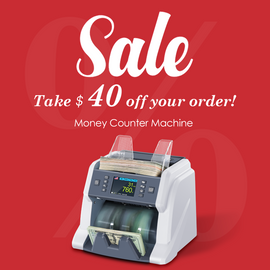Cash counting machines are one of the most important pieces of equipment for businesses that regularly handle cash. The ability to quickly and accurately count large amounts of money is a key advantage of using these machines. But there's another big thing they do - they can check if the money is real or fake, with their effectiveness in detecting fakes largely depending on the technology they use. In this article, we’ll look at how cash counting machines can detect counterfeit bills, as well as the benefits and drawbacks of using them.
What Is a Cash Counting Machine?
A cash counting machine is a device that automates the process of counting and sorting money. It can count both coins and bills, and is often used in banks, retail stores, and casinos. These machines employ a variety of technologies to ensure accurate counts, including infrared sensors, ultraviolet scanners, and magnetic readers.
How Do Cash Counting Machines Detect Counterfeit Bills?
Many counterfeiters have become increasingly adept at creating fake money, so businesses must take extra precautions. Cash counting machines use a variety of methods to identify genuine bills from fraudulent ones.
The first method of detection used by cash counting machines is the detection of magnetic properties in banknotes. Each denomination of U.S. currency has its own unique magnetic signature, which is incorporated into the design of the bill by the Treasury Department. Therefore, when a suspect bill passes through the machine, it can be quickly detected if it does not match the expected magnetic signature.
In addition to detecting magnetic properties, cash counting machines also check for size, weight, and color. Counterfeit bills typically lack the correct size, weight, and coloration of genuine bills. For example, U.S. currency is printed on a special type of paper that has a unique feel and thickness, whereas most counterfeit bills are printed on standard paper. Similarly, the coloration of counterfeit bills often differs slightly from the genuine article.
A third method of detection used by cash counting machines is the use of ultraviolet light. Many bills contain small areas of fluorescent ink that are invisible to the naked eye, but emit a specific pattern of light under ultraviolet light. When a suspect bill is passed through the machine, the fluorescent pattern of the ink can be compared against a database of known patterns. If there is a significant discrepancy between the two patterns, the bill can be identified as counterfeit.
Other methods of detecting counterfeit bills include the use of infrared light, magnetic readers, and image analysis. Infrared light is used to detect the bill’s watermark, while magnetic readers detect the security strip embedded in the paper. Image analysis looks for discrepancies between the bill and an approved image stored in the machine’s memory.
Finally, many cash counting machines are equipped with software programs that can detect tiny imperfections in a bill's design. These software programs compare the suspect bill to a database of known genuine bills, and look for discrepancies in the design of the bill. This can help detect even the most sophisticated counterfeits.
For those who are curious to dive deeper into the specifics of how these detection technologies work and want to understand the principles behind them, please continue reading: the meanings and functions of IR, MG, CIS, MT detection.
Benefits of Using Cash Counting Machines
The primary benefit of using a cash counting machine is the speed and accuracy with which it can count large amounts of money. These machines can count up to 1,000 bills per minute, so businesses don’t need to spend hours manually counting cash. This saves time and money, and makes it easier to keep track of transactions.
Another advantage of cash counting machines is their ability to detect counterfeit bills. As mentioned earlier, these machines use a variety of technologies to identify fraudulent notes, so businesses can be sure they’re not accepting fake money.
Drawbacks of Using Cash Counting Machines
Despite their advantages, there are some drawbacks to using cash counting machines. The most significant drawback is the cost. These machines can be expensive, so smaller businesses may not be able to afford them. Additionally, these machines require regular maintenance and calibration to ensure they are working correctly.
Conclusion
Cash counting machines are an invaluable tool for businesses that handle large amounts of cash. They can count money quickly and accurately, and they can also be used to detect counterfeit bills. While these machines can be costly, the advantages they provide are worth the investment for many businesses.







